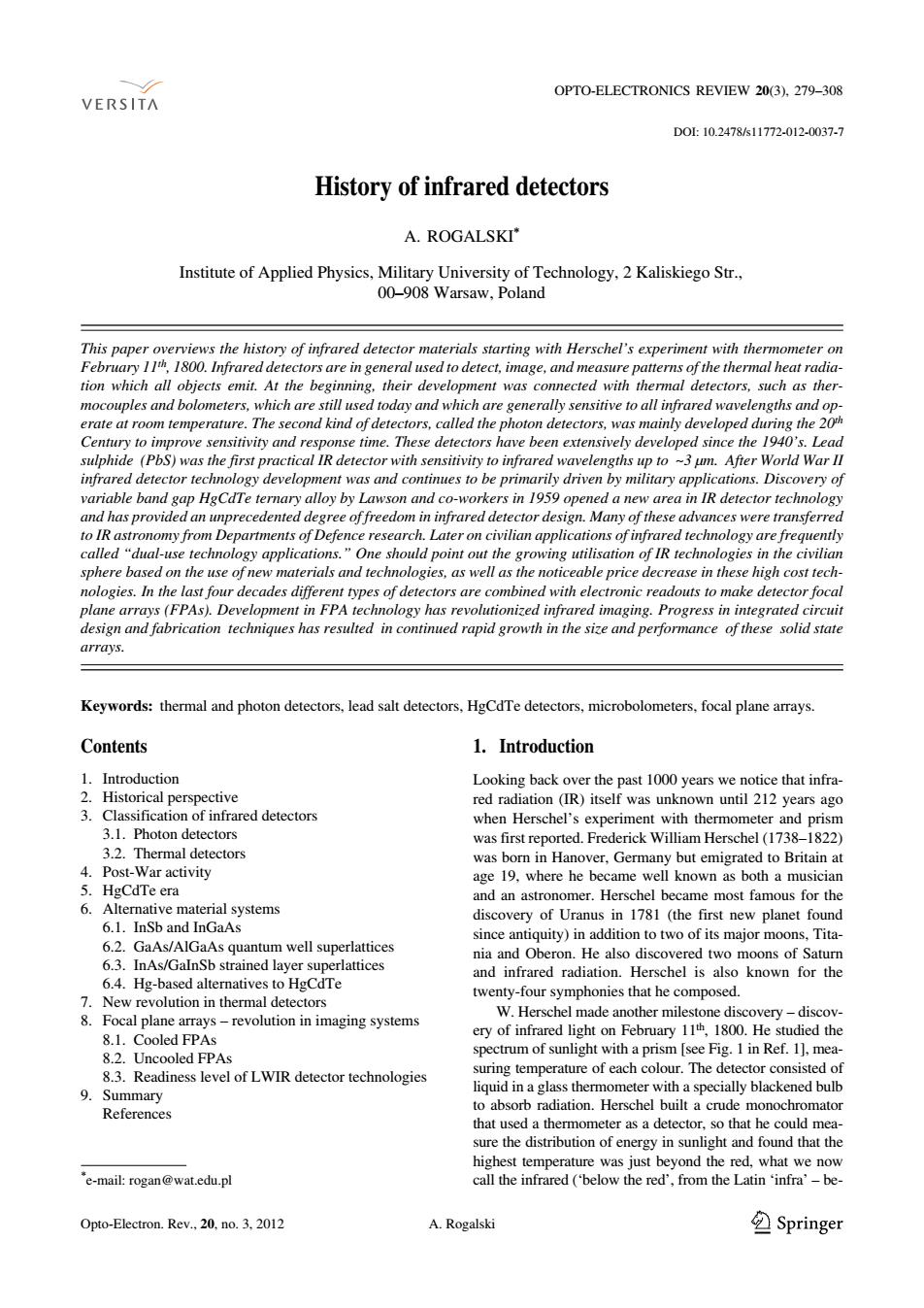正在加载图片...

OPTO-ELECTRONICS REVIEW 203).279-308 VERSITA D0:10.2478k11772-012-0037- History of infrared detectors A.ROGALSKI' his pape with Herschel'se nd m e pat on y ects emt their de was con erate at ro temperature.The second kind of dete rs.called the p ly developed duri the 20 C ry and re been ext develope lications.Dis able bar gap HgCdTe te mary alloy by Lawson and co-worke d a ne area to iras artments of Defen esearc Later on civilian annlicatic nth dual-use d rapid gr Keywords:thermal and photon detectors.lead salt de ors HeCdTe detectors,microbolometers.focal plane arrays. Contents 1.Introduction Looking back over the past 1000 years we notice that infra red radiation (TR)itself was unknown until 212 years ag 3.1.Photon detectors 1/173Q 822 was bomn in Hanover.German but emigrated to britain a 4. ecame well known as both a musician of mer.E s in 1781 (the since antig 6.2.GaAs/AlGaAs quantum well superlattices ned lay symphonies that he co .C -revolution in imaging systems V.He ery of infrared 82.U 1in Ref.I 8.3.Readiness level of LWIR detector technologies d of 9 that used a thermometer as a detector so that he could mea e the distribution of energy in sunlight and found that th 'e-mail rogan@wat.cdu-pl Opto-Electron.Rev.20.no.3.2012 A.Rogalski ②Springer History of infrared detectors A. ROGALSKI* Institute of Applied Physics, Military University of Technology, 2 Kaliskiego Str., 00–908 Warsaw, Poland This paper overviews the history of infrared detector materials starting with Herschel’s experiment with thermometer on February 11th, 1800. Infrared detectors are in general used to detect, image, and measure patterns of the thermal heat radia− tion which all objects emit. At the beginning, their development was connected with thermal detectors, such as ther− mocouples and bolometers, which are still used today and which are generally sensitive to all infrared wavelengths and op− erate at room temperature. The second kind of detectors, called the photon detectors, was mainly developed during the 20th Century to improve sensitivity and response time. These detectors have been extensively developed since the 1940’s. Lead sulphide (PbS) was the first practical IR detector with sensitivity to infrared wavelengths up to ~3 μm. After World War II infrared detector technology development was and continues to be primarily driven by military applications. Discovery of variable band gap HgCdTe ternary alloy by Lawson and co−workers in 1959 opened a new area in IR detector technology and has provided an unprecedented degree of freedom in infrared detector design. Many of these advances were transferred to IR astronomy from Departments of Defence research. Later on civilian applications of infrared technology are frequently called “dual−use technology applications.” One should point out the growing utilisation of IR technologies in the civilian sphere based on the use of new materials and technologies, as well as the noticeable price decrease in these high cost tech− nologies. In the last four decades different types of detectors are combined with electronic readouts to make detector focal plane arrays (FPAs). Development in FPA technology has revolutionized infrared imaging. Progress in integrated circuit design and fabrication techniques has resulted in continued rapid growth in the size and performance of these solid state arrays. Keywords: thermal and photon detectors, lead salt detectors, HgCdTe detectors, microbolometers, focal plane arrays. Contents 1. Introduction 2. Historical perspective 3. Classification of infrared detectors 3.1. Photon detectors 3.2. Thermal detectors 4. Post−War activity 5. HgCdTe era 6. Alternative material systems 6.1. InSb and InGaAs 6.2. GaAs/AlGaAs quantum well superlattices 6.3. InAs/GaInSb strained layer superlattices 6.4. Hg−based alternatives to HgCdTe 7. New revolution in thermal detectors 8. Focal plane arrays – revolution in imaging systems 8.1. Cooled FPAs 8.2. Uncooled FPAs 8.3. Readiness level of LWIR detector technologies 9. Summary References 1. Introduction Looking back over the past 1000 years we notice that infra− red radiation (IR) itself was unknown until 212 years ago when Herschel’s experiment with thermometer and prism was first reported. Frederick William Herschel (1738–1822) was born in Hanover, Germany but emigrated to Britain at age 19, where he became well known as both a musician and an astronomer. Herschel became most famous for the discovery of Uranus in 1781 (the first new planet found since antiquity) in addition to two of its major moons, Tita− nia and Oberon. He also discovered two moons of Saturn and infrared radiation. Herschel is also known for the twenty−four symphonies that he composed. W. Herschel made another milestone discovery – discov− ery of infrared light on February 11th, 1800. He studied the spectrum of sunlight with a prism [see Fig. 1 in Ref. 1], mea− suring temperature of each colour. The detector consisted of liquid in a glass thermometer with a specially blackened bulb to absorb radiation. Herschel built a crude monochromator that used a thermometer as a detector, so that he could mea− sure the distribution of energy in sunlight and found that the highest temperature was just beyond the red, what we now call the infrared (‘below the red’, from the Latin ‘infra’ – be− Opto−Electron. Rev., 20, no. 3, 2012 A. Rogalski 279 OPTO−ELECTRONICS REVIEW 20(3), 279–308 DOI: 10.2478/s11772−012−0037−7 * e−mail: rogan@wat.edu.pl